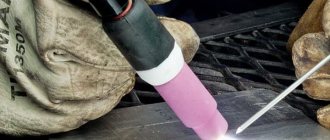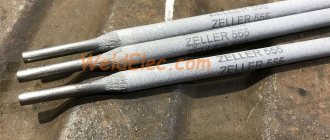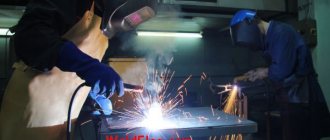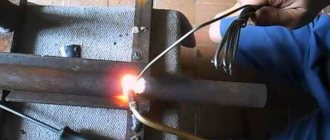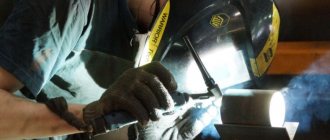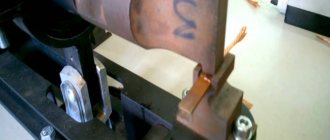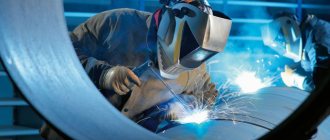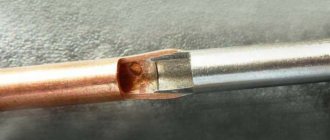Alloying of steels is carried out to obtain special properties that allow the material to be used in various extreme conditions for conventional steels.
Welding alloy steels has its own specifics, because it is necessary not only to obtain the necessary physical and mechanical reliability of the weld joint, but also to preserve the characteristics of the base alloy in it.
Material properties
Based on the amount of specially introduced impurities, alloyed (ennobled) steels are divided into:
- low alloy;
- medium alloyed;
- heavily alloyed.
In low-alloy structural steels, the amount of specially introduced impurities does not exceed 2.5%. In medium-alloyed alloys it reaches 10%, in highly alloyed alloys there are more than 10% of impurities.
Alloying additives most often are chromium, nickel, molybdenum, manganese, tungsten, aluminum, cobalt, vanadium, nitrogen, boron, titanium, silicon, niobium. Alloys are alloyed to obtain high mechanical and other properties.
Selection of fluxes
The connection of high-alloy steels can be carried out under a layer of flux, which helps to obtain welding joints of high quality and reliability. However, the features of the technology allow this type of welding to be used only for seams in the lower position. A large number of flux grades have been developed for different grades of materials being welded. They must be selected wisely. As an example, we can give the composition of one of the characteristic types of flux:
- marble 28%;
- porcelain 30%;
- ferromanganese 10%;
- ferrosilicon 6%;
- ferrotitanium 6%;
- titanium dioxide 20%
This is the composition of flux brand NZh-8.
Low alloy
In low-alloy and low-carbon alloys, the presence of carbon is less than 0.18%. They have ductility, good weldability, and are not brittle.
Steels 14G2, 15GS are low-alloy steels. High consumer qualities are achieved through the use of manganese, chromium, nickel, silicon and hardening of the alloy. Additives provide increased resistance to corrosion.
Characteristics
The main characteristics of welding quality is the resistance of the welded seams to cold cracks due to their fragility. Such alloys have a small percentage of carbon, nickel, and silicon. With the correct welding conditions and the use of the required additives, there will be no hot cracks.
For each type of low-alloy steel there is a maximum and minimum allowable cooling rate of the alloy around the weld. Depending on these limits, the range of welding work is selected. The amount of preheating of the workpieces also depends on this.
If the cooling rate limits are observed, cold cracks will not form around the seam.
Technology
For manual electric welding of alloy steels with 2.5% impurities, electrodes E70 and similar electrodes with calcium fluoride flux are used. The current strength is determined by the thickness of the metal, electrode, and its brand.
Welding must take place without stopping. Before the next pass, the temperature of the weld and the entire product must be above the preheating temperature (more than 200 °C).
When using flux, steel is welded using direct current. The current should be in the range of 800 A and the voltage 40 V. The welding speed should be in the range of 13-30 m/hour.
When butt welding, in order to avoid excessive strength of the weld, Sv-08KhN2M is used to fill it. When welding, the workpiece must lie on a flux pad if one-pass welding is used.
When welding low-alloy alloys in an inert gas environment, various materials are used. When working in carbon dioxide, use wire Sv-08G2S, Sv-10KhG2SMA.
When working with argon, the Sv-08HN2GMYU brand is used. It increases the mechanical strength of seams and their resistance to frost. It is recommended to use it for welding corner joints.
When using gas welding for alloy steel, due to strong long-term heating of the heat-affected zone of the welded part, alloying metals burn out, which reduces the corrosion resistance of the weld and its reliability.
To reduce the negative effect of prolonged overheating, filler wire SV-10G2, Sv-18KhGS and the like are used to restore the concentration of alloying metals in the weld.
After completing the welding process, to increase the mechanical strength of the seam, it is forged at a temperature of 800-850 ⁰C, then normalized.
Medium alloyed
Medium alloy steels are mainly alloyed with nickel, chromium, molybdenum, vanadium, the carbon content exceeds 0.4%. After hardening, the steel becomes strong, tough and ductile. Medium alloy steels of the KhVG, KhVSG, 9HS grades are widely used in the manufacture of drills.
These alloys are made from pure charge. It is cleaned of sulfur, phosphorus and other harmful inclusions. If necessary, electroslag remelting is used and refined with artificial slags.
The result is steel with excellent physical and mechanical characteristics. To further improve the characteristics of the alloys, medium-alloy steel is subjected to hardening and forging.
Ensuring seam quality
To ensure the required quality of welds, it is necessary to select welding materials in such a way that after welding the result is a seam that is close in physical and mechanical properties to the material being welded.
Since the base metal of the product is involved in the welding process, the welding materials used should have the amount of alloying impurities slightly less than in the base metal. This allows you to achieve the required level of strength and ductility of the seam.
When high-strength, medium-alloy steels with deep calcination are welded, it is necessary to select welding materials that minimize the presence of hydrogen in the welding zone.
This can be achieved by low-alloy electrodes, which have no organic materials in the coating, and which are subjected to high-temperature calcination before use.
In addition, when welding, you need to get rid of moisture, rust and other substances that can saturate the weld pool with hydrogen.
Electrodes
When welding medium-alloy steels, electrodes E-13Х25Н18, E-08Х21Н10Г6 and wire Sv-08Х20Н9Г7Т and Sv-08Х21Н10Г6 are used.
When using argon arc welding with a non-consumable electrode, you can obtain good quality welds on medium-alloy steels.
The use of activating fluxes increases the depth of the weld pool . Automated welding produces a uniform depth of metal penetration. For activating fluxes, the most resistant tungsten is used.
Gas welding for medium-alloyed metals is used using oxygen acetylene. It produces a high-quality seam, but it is still preferable to use electric welding.
Welding alloy steels
Alloy steels include special alloying elements: chromium, nickel, tungsten, molybdenum, vanadium, titanium and others. Alloy steels also include those steels that have a high content of manganese and silicon. Alloy steels have higher mechanical properties compared to carbon steels, as well as special properties that are necessary for the operation of products in conditions of deep cold, aggressive environments, high temperatures and pressures.
For alloy steels, an alphanumeric designation is adopted. Using these designations, you can approximately determine the chemical composition of steels.
State standards have adopted the following designations for alloying elements (see Table 67).
Table 67. Symbol of alloying elements
The numbers in front of the steel grade indicate the average carbon content in tenths of a percent for high-alloy steels, and in hundredths of a percent for low-alloy steels.
The number after a particular letter indicates the average percentage of that element. If there is no number after the letter, then the content of this element is about one percent. The letter “A” at the end of the mark indicates increased quality of steel. This steel has a limited content of harmful impurities.
An example of deciphering the composition of steel by its marking.
The 1Х18Н9Т marking refers to stainless steel containing on average 0.1% carbon, 18% chromium, 9% nickel and up to 1% titanium.
The ZOHGSA marking refers to low-alloy steel, which contains about 0.30% carbon, and the content of chromium, manganese and silicon does not exceed 1% for each element separately. The content of harmful impurities is limited: sulfur 0.03%, phosphorus 0.035%.
Alloying additives have the following effect.
Chromium is introduced into structural steel in the range of 0.7–1.75%. In special steels the chromium content reaches 30%. Chromium promotes the hardening of steel and somewhat reduces the plastic properties of steel; it is often added to alloys along with other alloying impurities, for example, nickel, molybdenum, etc.
Nickel greatly improves the strength and ductility of steel. The nickel content in alloyed structural steels reaches up to 5%. In special steels, nickel can be up to 50%. Most often, nickel is used in combination with other elements (chromium, silicon, etc.).
Molybdenum in structural steels is usually contained in small quantities - up to 0.60% - Molybdenum reduces the tendency of steel to overheat, increases its resistance at elevated temperatures, eliminates the phenomenon of brittleness during tempering, increases impact strength, and also improves the machinability of steel in cold and hot states .
Vanadium is introduced into alloyed structural steel in quantities of 0.2-0.3%. A very valuable property of small quantities of vanadium is its ability to refine grain in steel. Vanadium increases the steel's resistance to overheating and also significantly improves the mechanical properties of steel.
Titanium is introduced into steel in small quantities - about 0.5%. Has the same effect as vanadium. In addition, titanium increases the toughness of steel and improves its welding properties.
Manganese is contained in any steel in quantities of 0.3–0.7%. Manganese is introduced as an alloying impurity in amounts up to 14-17%. Manganese increases the hardenability of steel and improves its mechanical properties.
Silicon is included in any steel in the range of up to 0.6%. Silicon is added to alloy steels in an amount of 0.8–1.2% to increase elastic properties. A higher silicon content (up to 1.9%) causes a slight decrease in the plastic properties of steel and impairs weldability.
Welding alloy steel is highly dependent on its chemical composition, with the quantitative carbon content being of primary importance. Alloying additives have a weaker effect on weldability than carbon. The influence of alloying impurities varies, for example, chromium and manganese contribute to the formation of cracks more than nickel. The titanium additive has a beneficial effect on weldability.
Harmful impurities: sulfur, phosphorus and dissolved gases significantly impair the weldability of steel. To obtain normal welding results, the sulfur and phosphorus content should not exceed 0.020-0.055%.
www.prosvarky.ru
High alloy
Highly alloyed alloys usually contain at least 16% chromium and at least 7% nickel, in addition to other impurities. Thanks to these and other additives, high-alloy alloys are highly resistant to low temperatures, corrosion and high temperatures.
But each brand has its own specialization, in which it has extreme characteristics. According to their purpose, high-alloy steels can be divided into heat-resistant, heat-resistant and corrosion-resistant.
After heat treatment they increase their strength and ductility. When hardened, their ductile properties improve.
Specificity
High-alloy alloys have such outstanding characteristics that they are used wherever the feasibility and price of the product allows.
But each specific product has different requirements. Accordingly, when carrying out welding work, different requirements for strength and ductility are imposed on welded seams, which leads to different approaches to welding work. That is, everything here is individual.
The presence of a large number of approaches in welding high-alloy steels is due to the fact that they have very specific thermophysical properties.
They have a low coefficient of thermal conductivity and a high coefficient of thermal expansion. In combination, they place conflicting demands on the welding process.
Low thermal conductivity leads to an increase in the depth of steel penetration. A high coefficient of thermal expansion causes deformation, including warping of parts. To reduce warping, it is necessary to concentrate thermal energy as much as possible. Laser welding does this well.
When manual electric welding of high-alloy alloys, the same measures are carried out as when welding medium-alloy alloys. The main task is to minimize the entry of hydrogen into the welding zone, otherwise it causes the appearance of pores and cracks.
Choice of technology
For high-alloy alloys, gas welding is not recommended for acid-resistant steels, as it causes intergranular corrosion. Even when heat-resistant steels are used in welding, warping of products occurs.
Submerged arc welding has great advantages over manual electric arc welding due to the fact that the welding process takes place under protection in a constant environment with the same components. There is no need to change electrodes, which causes crater formation.
Submerged arc welding ensures a uniform weld with specified characteristics due to the protection of the weld pool from the external environment in the form of hydrogen.
In addition, preliminary work is reduced, since cutting edges is only necessary for thicknesses of more than 12 mm, and manual arc welding requires cutting edges for metal thicknesses of more than 5 mm.
Laser welding is the most effective for alloy steels due to the high concentration of energy in a small area. This allows you to virtually eliminate warping and deformation. Many alloyed alloys can be welded together, regardless of type, only when using laser welding.
Shielding gas
Along with electrodes and fluxes, argon, helium and carbon dioxide are used. These are shielding gases that can be mixed in certain situations.
This method is justifiably common among craftsmen. To weld high-alloy steel using shielding gas, tungsten electrodes will be required. They are good because they do not melt even at the highest welding temperatures.
Work should be performed with constant current and reverse polarity. The option of welding with direct polarity is possible if the metal contains a large amount of aluminum.
This will destroy the film that the oxides form. In turn, it prevents the formation of a seam.

